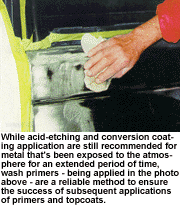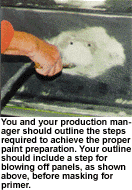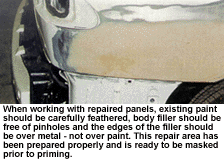The process of paint preparation has come a long way in the last 20 years. Before urethanes and basecoat/clearcoat refinishing systems became so popular, very few shops did much more than feather, prime and paint.
Today, it’s unusual to find a shop that doesn’t approach the preparation process with a clear understanding that the vehicle is leaving with a lifetime performance guarantee on the paintwork. This extensive guarantee, combined with refinements at the manufacturer level, has substantially raised the level of refinishing quality. Also consider that shops benefit from increased consumer satisfaction, which has become an important statistic affecting relationships with insurers.
All of this has occurred while the government has steadily increased the amount of regulations for the entire coatings industry. As a result, there’s been an ongoing scramble by paint company chemists to offer high-quality products that are compliant with current and pending legislation.
I think most of us would agree that we’ve never had products available that perform as well as they do now. For this article, we’ll specifically examine state-of-the-art preparation products and the best practices that accompany them.

Do You Have Chemistry?
Eenie-meenie-miney-mo, catch a substrate by the toe … aluminum, galvanized, HSLA steel, galvaneal (that’s just metal).
Our primary concern when confronted with a metal substrate is to minimize corrosion and maximize the life of the paint finish. Over the years, vehicle manufacturers have adopted a very stringent regimen of cleaning and treating body assembly parts prior to painting. These phosphating processes convert the top surface of the metal into a highly insoluble, corrosion-resistant coating that provides the primary bond between the substrate and the paint.
It would be nearly impossible to duplicate what the manufacturer does, but paint companies have provided us with some sound alternatives. While acid-etching and conversion coating application are still recommended for metal that’s been exposed to the atmosphere for an extended time period, wash primers, or acid-etching primers, are a reliable method to ensure the success of subsequent applications of primers and topcoats.
"The typical two-component etching primer has one resin component and one acid-bearing component," writes Earl Groshart in "Preparation of Nonferrous Metals for Painting." "The acid reacts with the metal surface, forming a metal phosphate. As the solvents evaporate, the very thin resin forms a stabilizing coating over the phosphate and promotes adhesion of subsequent coats."
The availability of one product that addresses the wide variety of metal substrates we encounter in a modern collision shop is a tremendous advantage for collision refinish technicians. It’s important to remember that each paint manufacturer has designed a chemically compatible family of products. Each component of these paint systems is designed to complement the subsequent components. This isn’t the time to indulge in do-it-yourself chemistry. However, it is the time to commit your paint department to a productive and repeatable method to ensure proper paint preparation.
You, as the owner, and your production manager should be involved in a planning session outlining the steps required to achieve the desired result. Your paint distributor and paint company representative should be able to assist you in this department.
When you’ve determined the quality standard to be met, type up and print out the labor operations and products required for each step. Have it enlarged and laminated, posting it in the paint department. This way there’s no doubt about what’s required when the vehicle rolls into the paint shop. Your list might include the following:

• Clean each panel with soap and water.
• Clean each panel with wax and grease remover. Use clean, lint-free towels.
• Feather-edge all repaired areas with 80/150/220/320.
• Blow off panels and mask for primer.
• Apply 2K acid-etching primer — one coat, 30-minute dry.
• Apply 2K primer-surfacer to feathered areas — two to three coats of infrared bake.
It’s important that you address the most common refinishing situations that occur in your shop. These will likely include new panels, repaired panels, used panels, flexible parts and welded repairs. If you’re a part of a multiple-location business, all refinishing personnel should be trained in the same methods and product usage. This facilitates temporary work assignments for refinish department employees to manage production.
New Panels
New, undamaged original equipment (OE) replacement panels should represent a bright spot in your day. With the factory applied e-coat primer in place, these panels can be run through a paint department very quickly.
Most paint manufacturers have one or two primer/sealer products that can be applied to cleaned and unsanded e-coat. These products typically allow for a wet-on-wet application of topcoats. Check with your paint manufacturer for recommendations.
This sound use of chemistry is to your advantage because it will increase your productivity dramatically, and all finished work will still fall under the paint company’s extended warranty program. (Note: I’m talking about parts from OEMs with an OEM factory-applied electro-deposition primer. Non OEM parts — aftermarket parts — don’t fall under these recommendations.)
Repaired Panels
Door skins and other panel repairs create a situation where you deal with a number of substrates. Bare metal, body filler, feathered original finishes and prior repairs done to a vehicle can all be present on one job. Your analysis should include a close inspection of each surface involved.
Existing paint should be carefully feathered, body filler repairs should be free of pinholes and the edges of the filler should be over metal — not over paint. The entire repair should be carefully solvent-washed, with etching primer applied to bare metal areas and primer-surfacer applied over the whole repair area. If any spot or tack welds were used to attach a door skin, they should be wire-brushed prior to applying etching primer.

Used Panels
A super clean, undamaged used front end that matches the vehicle color and has all the right moldings is the stuff of dreams. Used parts may have a place in the vehicle repair process, but be ready for a lot of prep work.
Prior to cutting in the edges, much cleaning and disassembly usually takes place. Hoses, wiring harnesses, washer tanks, overflow tanks and any other obstructions must be removed. Light assemblies and moldings may also get in the way. If you see evidence of prior paint work on the used part, you may need to strip it. Stripping might then remove the body filler from previous repairs. That means that you must re-repair any affected areas.
My advice is to estimate carefully after a detailed inspection of used assemblies. A film-thickness gauge will let you know quickly if extensive paint work is required. Keep in mind that the times in the estimating manuals and estimating systems are for new, undamaged parts. If you aren’t careful in your inspection, your profit potential will vaporize. Write it right.
Flexible parts
@#$%!@!!
That about sums it up for flexible parts. Most plastics, after they’re cleaned of all contaminants, are paintable with certain kinds of paint systems. Some plastics, however, despite a completely clean surface, won’t accept paint. But the only accurate way to predict paintability on plastic is to try to paint the plastic.
Plastic suppliers will do almost anything to confuse us, but external mold releases give us a fighting chance. Thorough cleaning with soap and water, followed by judicious use of an appropriate solvent, is generally effective on these parts.
Some internal mold releases that are part of a proprietary compound have been designed by some plastic manufacturers. And then there are the polyolefin-type plastics — like polyethylene and polypropylene — with that waxy surface we’ve all come to know and love. And I must not neglect to mention the multitude of non-OEM manufacturers and rebuilders who seem to apply anything that comes out of a spray gun to their products. In fairness, some of the large vendors in the marketplace have made an effort to use coatings on their parts that give a painter something to work with.
You need to keep up with your paint system manufacturer recommendations for your product line. I think we all need to encourage the paint companies and the producers of plastic repair materials for the automotive market to compare notes. Why? Because the repair is no good if I can’t paint it and the paint is no good if it won’t work on the repair. I believe it’s in the best interest of these parties to work together and publish recommended procedures when their products are used together.
Keep Learning to Keep Earning
The best thing you can do to ensure your success in developing top-notch preparatory skills is to be hungry for knowledge. Read industry trade magazines and talk to factory people at clinics and in your shop.
The industry you’re a part of is changing rapidly. Materials you consume in your work and materials you’ll confront on vehicles in your shop will continue to change. The need to improve fuel economy, the need for lighter vehicles and the consumer demand for quality repairs will continue to escalate. As you read this article, there’s somebody out there who’s stripping that bumper cover again. The customer has been back five times and the rental is coming out of his paycheck. He doesn’t have a plan or a clue. Don’t let this be you.
Writer Michael Regan is president of The J.J.R. Company in Cleveland, Ohio, and a contributing editor to BodyShop Business.
Photos courtesy of Padula’s Body Shop in Tallmadge, Ohio.













